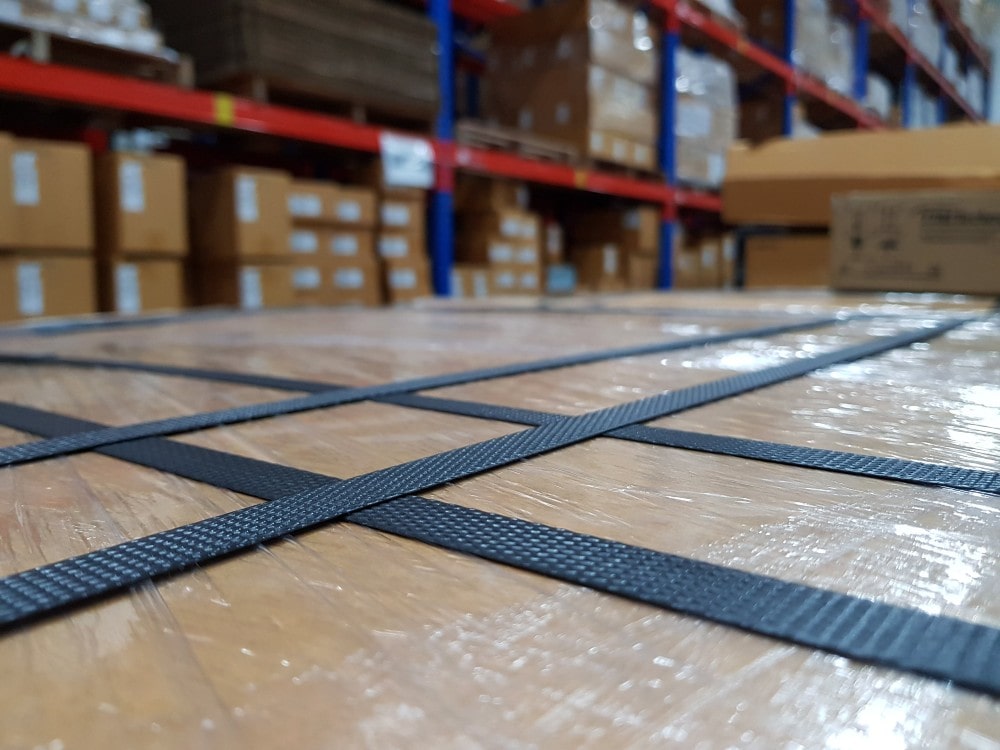As a business owner, we know you’re always looking for reliable solutions to enhance your packaging operations. One of these solutions is plastic banding, a versatile and cost-effective method for securing and bundling products. Learn the perks of using plastic banding, how to maximize its effectiveness, tips for proper application, and the many advantages it offers for your business.
What is Plastic Banding for Packaging and Shipping?
Plastic banding is also known as plastic bands, plastic strapping, and plastic straps. This material is wrapped around pallets of products or individual boxes to secure goods for storage or shipment. It is used along with a manual or battery-operated banding tool or an automatic banding machine.
Different types are available for specific applications.
- High-recovery nylon strapping elongates or contracts when the pallets or boxes shift or settle. It is a popular alternative to polyester strapping and less expensive than steel strapping.
- Polypropylene (PP) banding is normally the most cost-effective option ideal for light to medium-duty applications.
- Polyester (PET) banding offers higher tensile strength and is perfect for heavy-duty applications and a cost-saving replacement for steel strapping.
The Benefits of Plastic Banding for Your Business
With its strength, durability, versatility, and different types available, plastic bands can be a game-changer for your business’s packaging needs.
Plastic straps are robust and adaptable and hold numerous advantages over other strapping materials. Whether you’re running a manufacturing unit, a distribution center, a logistics enterprise, or a home business, integrating plastic bands into your operations can significantly enhance your packaging efficiency.
Plastic strapping is renowned for its strength and durability. Similar to steel banding, it boasts high tensile strength, ensuring your packages remain securely strapped during transit or storage. Additionally, it’s resistant to rust, corrosion, and weather conditions, making it suitable for both indoor and outdoor applications.
Plastic banding is a popular choice across various industries owing to its versatility and adaptability. From bundling boxes, and securing pallet loads, to reinforcing cartons, plastic strapping is an ideal choice. It’s widely used in a variety of industries due to its flexibility; it conforms to various shapes and sizes, ensuring a firm and secure hold.
- Food and beverage
- Pharmaceuticals
- Electronics
- Construction
Maximizing Plastic Banding Efficiency for Your Business
Plastic straps are a reliable and versatile choice. To maximize its effectiveness, here’s a step-by-step guide and some pro tips.
Step-by-step Guide to Effective Strapping
- Pick the right banding considering the weight, size, fragility, and compressibility of the items you’re strapping.
- Arrange your items in a secure and stable position for easy application of the banding.
- Place the banding around the items, ensuring it’s secure but not overly tight.
- Use a tensioner tool to tighten the banding further.
- Seal the ends of the banding with a sealer tool to create a secure strap.
- Inspect the strapping to ensure it’s secure and tight. Make adjustments if required.
- Label the strapped items if necessary, providing details like handling instructions or product identification.
Tips for Secure and Tight Banding
- Use appropriate tension for the specific items you’re strapping.
- Consider using corner protectors to prevent banding from damaging the edges or corners of your items.
- Regularly inspect your banding and the plastic bander tool to ensure everything is in good shape.
Common Mistakes to Avoid
- Don’t use damaged or previously used banding.
- Avoid overtightening the banding as it can cause damage.
- Don’t use insufficient banding material as it may not provide enough strength to secure your items properly.
By observing these steps, tips, and warnings, you can ensure that your banding is used effectively and safely.
Maintaining and Storing Plastic Banding for Long-Term Use
Proper storage and regular maintenance of plastic strapping are essential to prevent damage and prolong its lifespan. Here are some tips on how to store and maintain your plastic banding.
- Keep it Dry: Store banding in a dry area to prevent moisture from weakening its integrity.
- Avoid Extreme Temperatures: Plastic banding can expand or contract in extreme temperatures, so store it in a climate-controlled environment.
- Protect from Sunlight: Prolonged exposure to sunlight can degrade the banding. Store it in a shaded area or use protective covers.
- Avoid Sharp Objects: Keep banding away from sharp objects that could cause damage.
Having the right banding tools and accessories can make handling and storing banding easier and more cost-effective. Here are some recommendations:
- Tensioning Tools: These tools properly tension plastic bands, ensuring secure strapping.
- Dispensers: Dispensers improve efficiency and reduce the risk of tangles or damage.
- Edge Protectors: These accessories prevent the banding from damaging your packaged products.
- Sealers and Buckles: These tools securely fasten banding, ensuring it stays in place during transit or storage.
Follow these storage and maintenance techniques with the right banding tools for your pack-n-ship process. This will ensure the longevity and optimal performance of your banding.
Plastic Banding Materials, Tools, and Equipment
Here at Fastpak Systems, we’re committed to providing you with top-tier packaging solutions, including an extensive range of high-quality plastic strapping products. If you find that steel strapping is better suited for your business needs, then we have a range of metal banders and metal strapping machines suited for all types of packaging and shipping needs.
If you are interested in learning more about plastic strapping and need help deciding what materials and equipment are best for your business, reach out to our experts today.
Contact Fastpak now to get started on making your business operations better.

